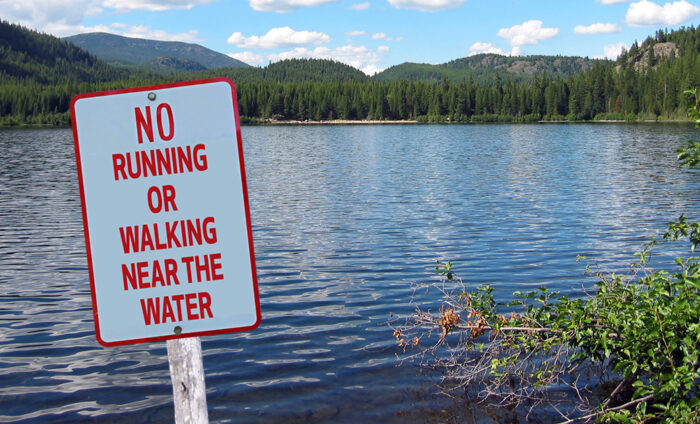
Councils should ban walking or running near water
In 2014, 138 people in the UK drowned after falling in while running or walking alongside water. Forty-six of these deaths occurred in rivers, 39 in the sea, 21 in canals, 10 in streams or ditches and 8 in lakes. In 2013, the total number was 126 with again 46 of these drowning fatalities happening in rivers. Clearly, walking or running alongside water is incredibly dangerous and should be banned.
Actually, we don’t think that at all. We just wanted to point out that it’s unimaginable that anyone would consider imposing a ban on walking or running by a river or lake. Yet, councils and water companies do ban people from swimming in open water and the emergency services frequently (especially at this time of year) tell us how dangerous it is to swim in open water and recommend we don’t do it.
The number of people who died while swimming in open water in 2014 was 30. This is obviously 30 too many, but it’s significantly fewer than the number of walkers and runners.
A further 14 people died from drowning while fishing. You do, of course, see “no fishing” signs – but these are meant to protect the fish or the environment, not to save anglers from drowning.
Open water swimming, for reasons we don’t fully understand, is a very emotive subject in the UK. Drowning deaths while swimming get widely reported – much more so, as far as we can tell, than drowning deaths for walkers, anglers or boat users – and there is a widespread conviction (even among competent pool swimmers) that open water is dangerous.
Part of the problem is that open water is undeniably dangerous if you lack experience, are reckless or under the influence of alcohol. On the other hand, if you are experienced, careful and sober the risks are very small. The messaging put out by emergency services and local authorities is for the first group and therefore seems unnecessarily alarmist and lacking in credibility to the second.
The current situation is unsatisfactory for a number of reasons. Scaremongering is an unpleasant and not particularly effective way to control behaviour. Those most at risk with a tendency to reckless behaviour will ignore it anyway, and it puts off lots of careful people for whom open water swimming poses little danger and could have lots of benefits. We obviously have commercial reasons for wanting to see more people swimming outside, but we also strongly believe that exercising outside, especially swimming, is a wonderful thing that should be enjoyed by as many people as possible. It’s therefore a shame that vast numbers of sensible people are put off open water swimming in an attempt to protect a few reckless ones.
More importantly, scaremongering doesn’t tackle the underlying problem, which is that too few people know how to swim and stay safe in open water. This starts with basic swimming ability in the pool, where we are already failing thousands of children in schools each year, but goes beyond this to teaching water awareness, an appreciation of the risks and basic survival skills.
And this takes us back to the first point. Banning people from walking or running near water could save more than 100 lives a year but no one is seriously going to advocate this, nor would it be feasible or desirable to fence off every coastal and riverside path to prevent people falling in. But some of these lives could potentially be saved if those people had regular experience of swimming outside and therefore reducing the risk of panic and cold water shock if they take a tumble.
The emergency services in the UK do amazing work. Anyone who puts their life at risk through their work to help save others (regardless of whether they’re in trouble due to bad luck or misjudgement) deserves our complete respect. Recovering the body of a drowned teenager must be a harrowing experience. So while we disagree with some of the messages put out by the emergency services we do understand why they feel it’s important to discourage people from open water swimming.
Going forward, we hope to broaden the dialogue between everyone with an interest in open water swimming from the emergency services, the RLSS, the ASA, Sport England, the Outdoor Swimming Society to swimmers themselves. We’d like to see a change in the messaging from “don’t do it” to “how to stay safe”. We’d like to see swimmers engaging in constructive discussions with councils and owners of potential open water swimming spots about safe access to water. And most of all, we’d like to see all children taught how to swim and how to stay safe in or near open water, whether they are walking, running, feeding the ducks, angling, kayaking, sailing or swimming.
As swimmers, we should concern ourselves primarily with creating a positive image about the activity we love and pushing the message that everyone should learn how to swim and stay safe.







